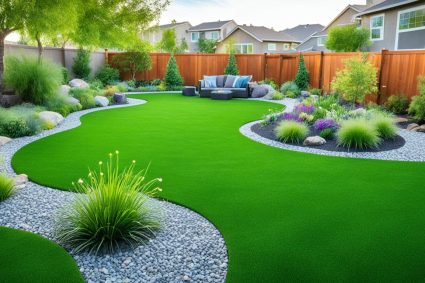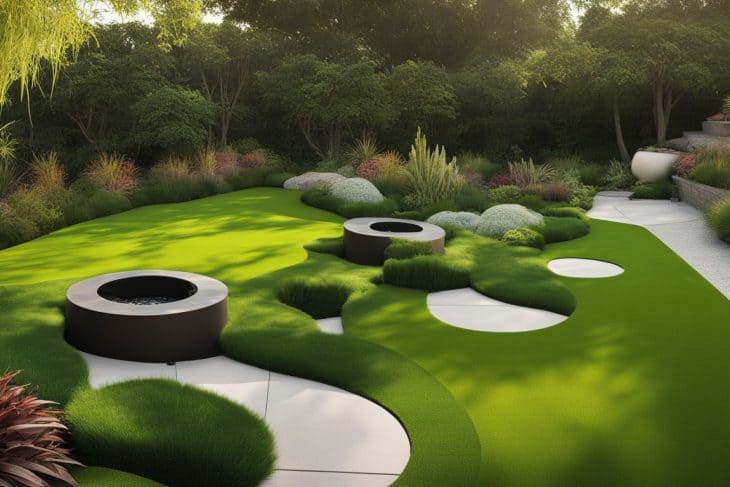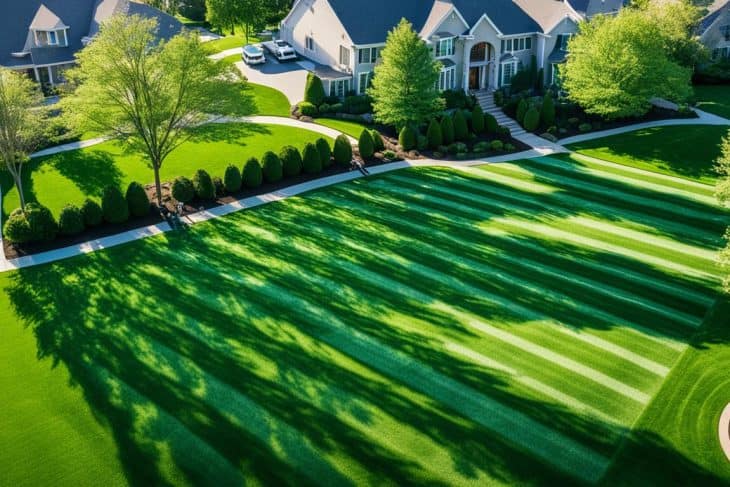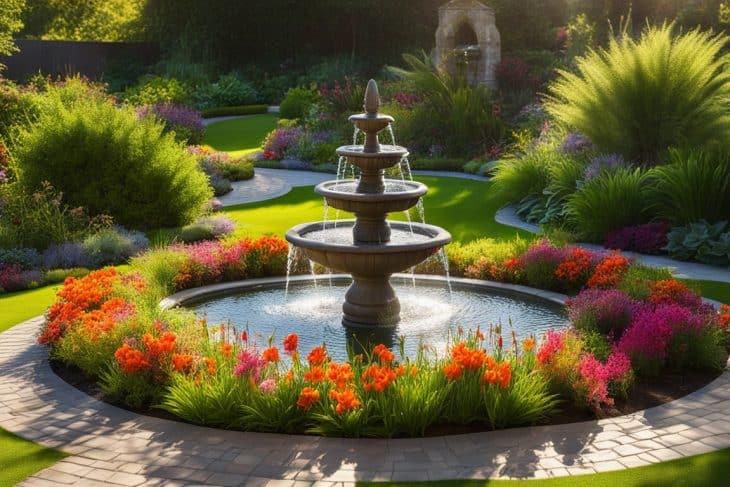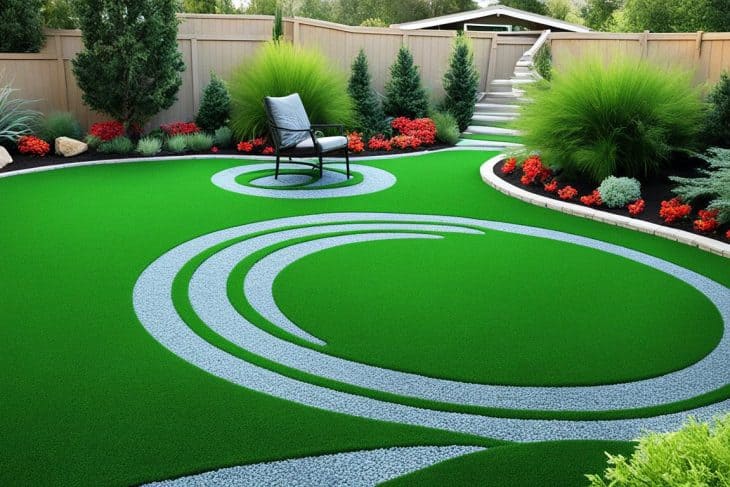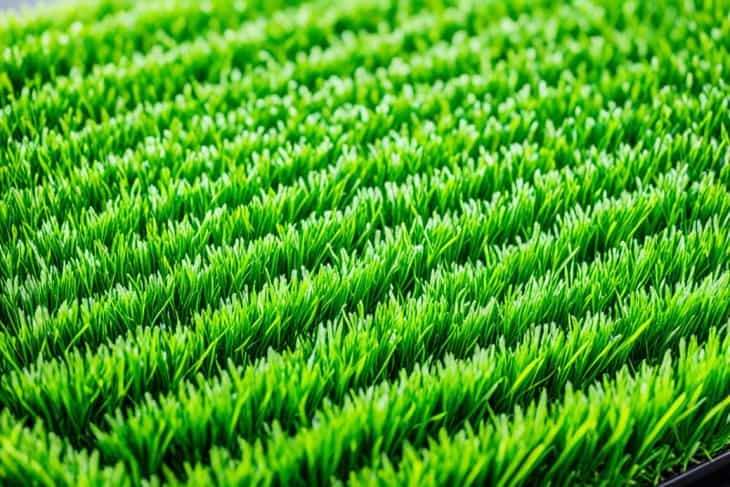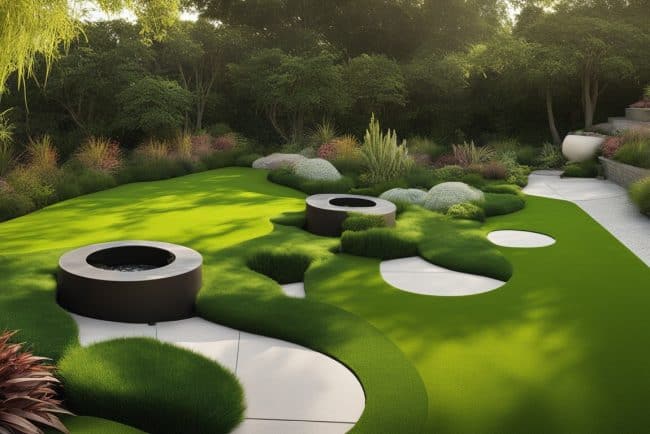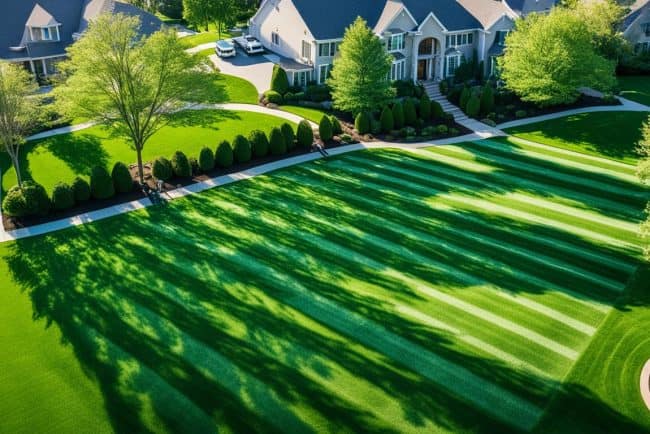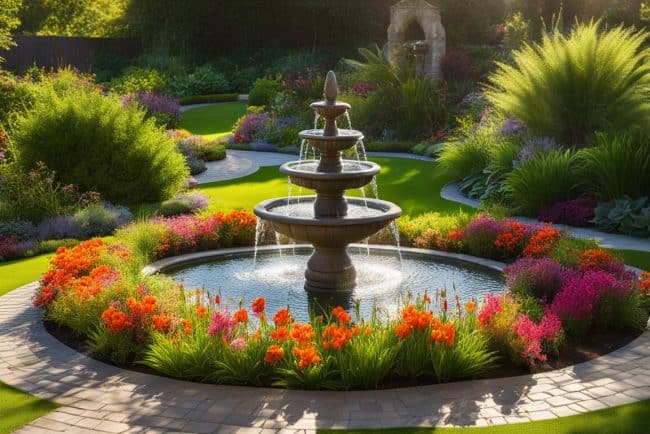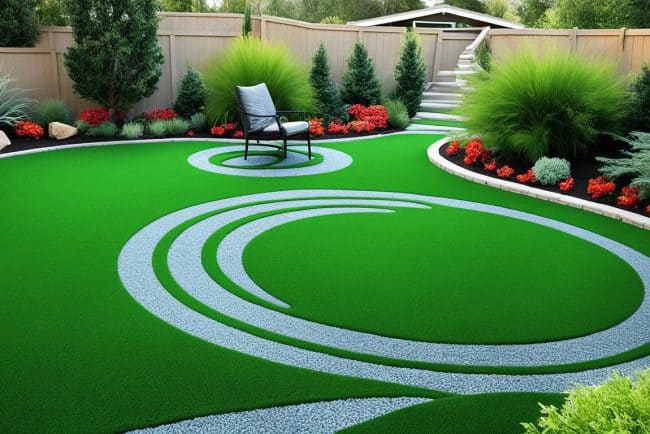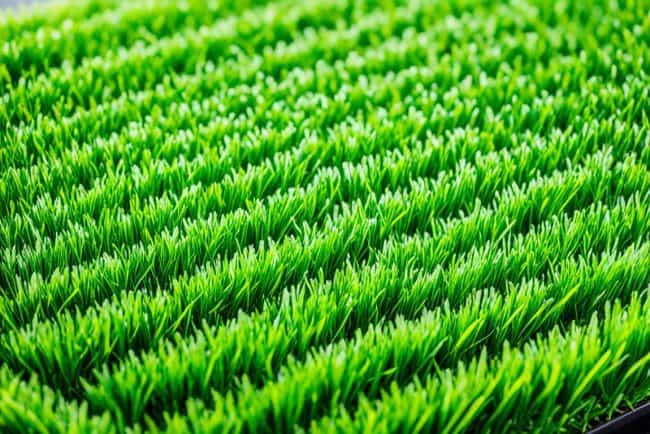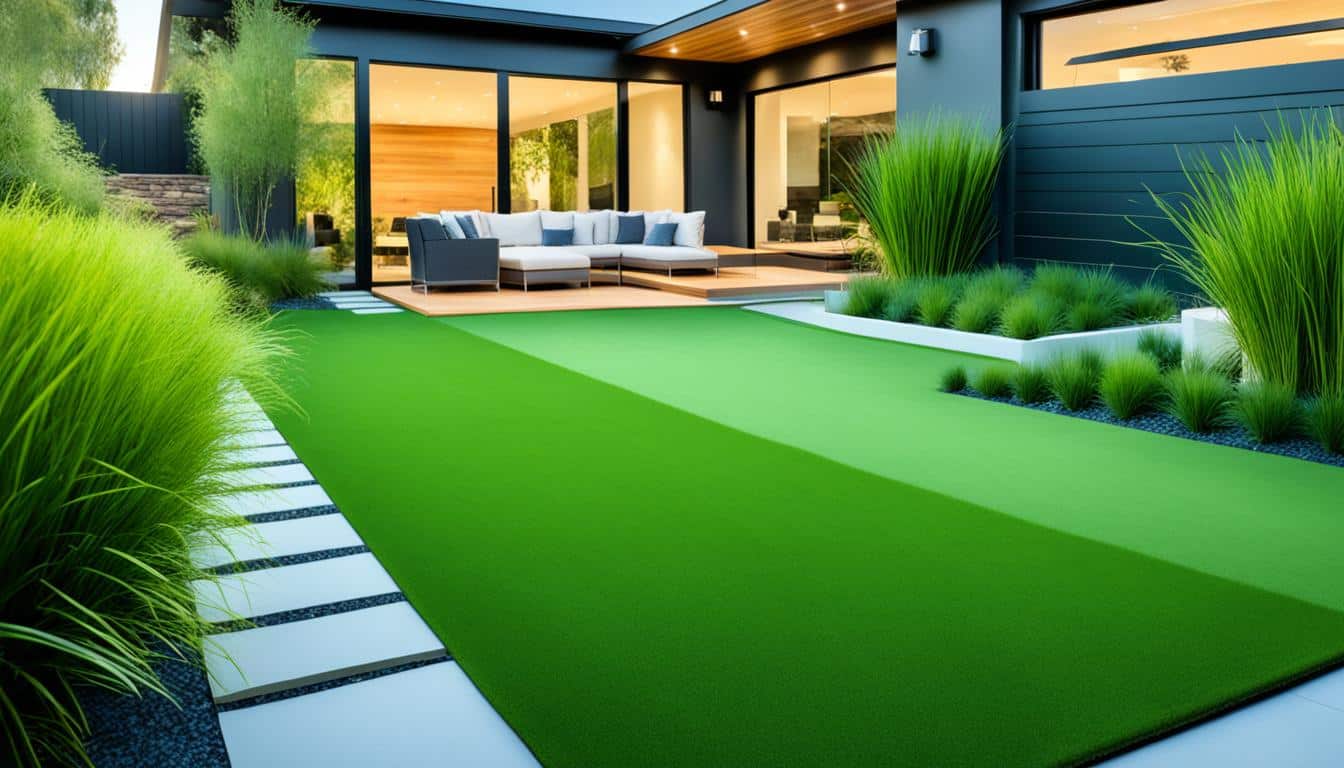
Did you know many homeowners are choosing artificial grass over natural? This shift comes as maintenance and durability of artificial grass win favor. It’s especially true in Florida where heat and humidity make yard care tough. Artificial grass offers an easy and stress-free solution to this problem. Let me show you how it can turn your outdoor space into a lush, easy-to-care-for oasis.
Key Takeaways
- Artificial grass is popular for its easy maintenance, durability, and year-round beauty.
- Nylon turf offers strength but can be stiff and expensive.
- Polyethylene turf provides a natural look and resilience in various weather conditions.
- Cost-effective polypropylene turf is best for aesthetics, not heavy foot traffic.
- The primary reason homeowners choose artificial grass is the ease of upkeep.
- Good drainage and groundwork are crucial for lasting performance.
- A well-maintained lawn of any kind adds significant value to a property.
Understanding Artificial Grass and Its Benefits
My journey towards a sustainable, easy lawn led me to artificial grass. This synthetic option changes outdoor spaces, giving them a lush look without the usual lawn care. I soon saw how artificial grass beats traditional lawns in many ways.
What is Artificial Grass?
Artificial grass is a synthetic product that mimics real grass. Often made from synthetic fibers, it’s popular for sports and home use. It’s appealing because it doesn’t need watering, mowing, or fertilizing. This makes it perfect for busy people like me.
The Advantages of Artificial Grass Over Natural Turf
Choosing artificial grass comes with many benefits. Let’s look at some major advantages:
- Water Conservation: Artificial grass can save up to 22,000 gallons of water each year. This is a big drop from natural lawns that need weekly watering during their growing season.
- Reduced Maintenance: No more mowing, trimming, fertilizing, or seeding. Artificial grass saves time and money on lawn care.
- Longevity: Good quality artificial lawns can last between 15-25 years. This is much longer than natural grass, which needs constant care.
- Environmental Benefits: Gas mowers create as much pollution as 11 cars per hour. Synthetic turf cuts down this pollution and is better for the environment.
- Cost-Effective in the Long Run: Though initial costs are $6 to $20 per square foot, money saved on water and upkeep makes it financially smart over time.
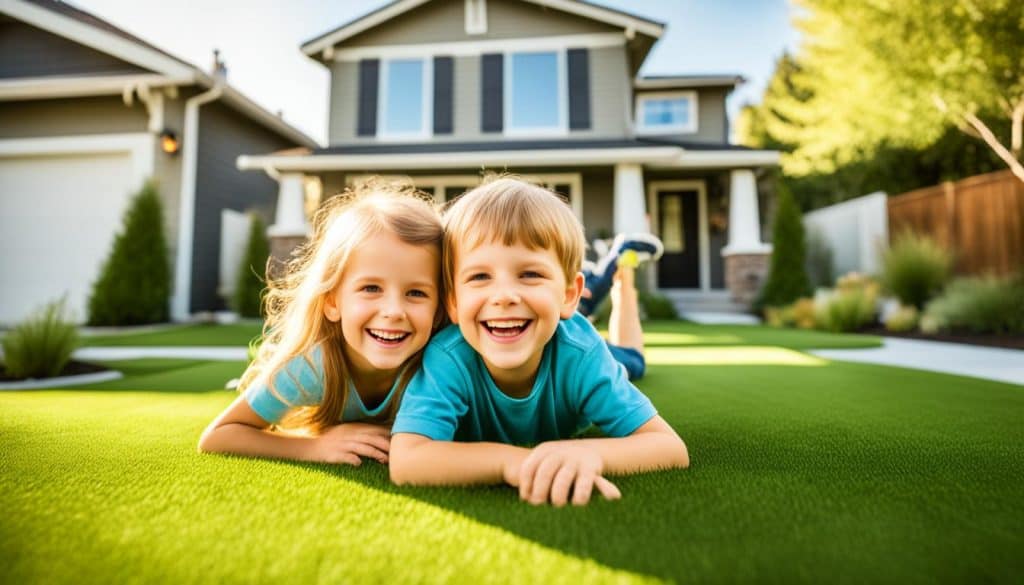
Thinking about a bright, easy lawn, artificial grass stands out. It not only makes outdoor areas beautiful but is also eco-friendly. Using artificial grass has changed how I view lawn care, letting me enjoy my yard fully.
Lawn Choices: Types of Artificial Grass Materials
Choosing the right type of artificial grass can change how your lawn looks and functions. There are three main kinds to consider: nylon, polyethylene, and polypropylene. Each one has its own benefits.
Nylon vs. Polyethylene vs. Polypropylene
Nylon is strong and can handle a lot of foot traffic. It’s great for busy spots. But, it can fade if it gets too much direct sunlight. Polyethylene looks more like real grass and feels softer. It’s good for those who want their yard to look natural.
Polypropylene, on the other hand, is the most cost-effective. It’s not as strong as the others, though. It works best in places that don’t get walked on a lot.
Determining the Best Material for Your Lawn
When picking the best turf, think about how much traffic your lawn gets. Also, consider what look you’re going for and how much you want to spend. Knowing about the different artificial grass materials can help you make the best choice for your yard.
Beauty and Functionality: Features of Artificial Grass
Artificial grass makes my outdoor space both lovely and useful. It’s all thanks to features like pile height and density and the colors and textures available. These aspects not only make my yard look better but also improve its use and performance.
Pile Height and Density Explained
The height and density of artificial grass are key. The height of the grass blades affects the look and feel of the turf. For sports, shorter grass works best as it’s tougher. But for home use, about 30 mm high is softer and looks luxurious.
Density means how many blades per square inch, and it matters a lot. It affects how the grass looks and lasts. More blades mean a thicker look and better durability against wear and tear.
Color and Texture Choices for Your Yard
I have so many choices in artificial grass color and texture. I can pick from bright greens to soft, natural shades. These options let my yard reflect my style. Different textures can make it look just like real grass.
With these choices, I can make my outdoor area exactly how I like it. Also, I can enjoy the constant beauty of synthetic turf. It’s an easy way to have a beautiful and inviting landscape that suits my taste.

Climate Considerations for Artificial Grass Installation
Choosing the right synthetic grass is key, especially in Florida. Our state’s heat and humidity can affect artificial grass. It’s important to consider our local weather for the best outcome.
Handling Florida’s Heat and Humidity
Florida’s heat and humidity require tough artificial grass. I picked Evergrass™ Emerald Green Turf 110 for its high UV protection. It keeps its bright green color for years, despite our intense sun.
Rainy Season and Drainage Solutions
The rainy season here needs smart drainage in artificial lawns. Proper installation helps prevent water buildup. Using materials with perforated backs helps water escape. It’s key for keeping my lawn looking great, even in heavy rains.
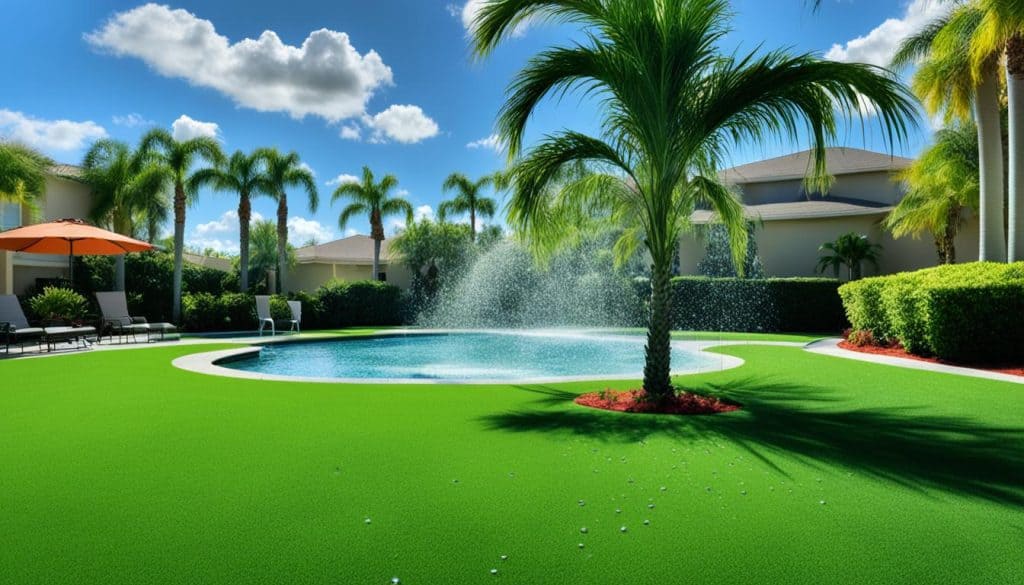
Maintenance Made Easy with Artificial Grass
Artificial grass needs less care than real lawns, but you still need to look after it. Following simple cleaning tips helps keep it looking good all year. This makes sure your fake grass stays nice and useful no matter the season.
Daily Upkeep and Cleaning Tips
Taking care of it every day saves time and work. I use tools like a leaf blower, hose, and broom for these chores. Here are the main tips:
- Remove leaves and debris regularly to stop them from piling up.
- Wash the turf with water to remove dust or dirt.
- For those with pets, quickly get rid of pet waste. Also, rinse the area often to keep it clean.
- Brush high-traffic spots monthly to keep the grass upright and prevent flattening.
- Check for weeds and pull them out by hand when you see them.
How to Prepare for Seasonal Changes
Seasons affect how you take care of artificial grass. In fall, I make sure to remove leaves to avoid mold and color changes. As winter nears, changing how I care for it is key. I keep the turf clean and watch out for ice. Every season has its own maintenance needs, but I adjust my care to keep my synthetic grass great in any weather.
Cost Analysis: Is Artificial Grass Worth It?
The cost for artificial grass is about $9 to $12 per square foot installed. Real grass costs much less, at $1 to $2 per square foot. But looking long-term, artificial grass can save money. Over 20 years, artificial grass costs about $15,000. Real grass can cost over $35,800 in that time. This shows artificial grass might be a smart money choice.
Artificial grass cuts down yearly spending by over $1,000. It uses much less water, under 80 gallons for cleaning compared to 620 gallons for real grass. Not needing lawn care tools saves more money and helps the planet too.
Good artificial grass lasts more than 20 years and can up your home’s value by 7%. While real grass costs build up over time, synthetic turf seems smart. It saves money and helps the environment. Choosing artificial grass means thinking ahead for your property and the planet.

